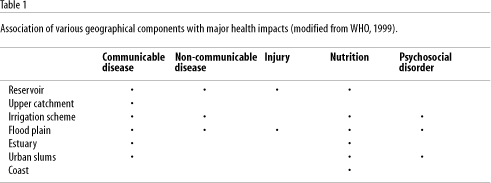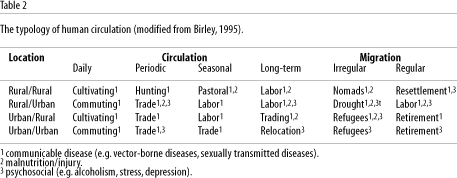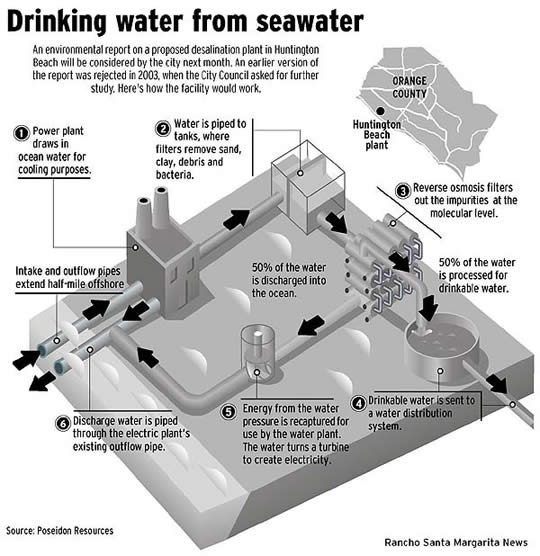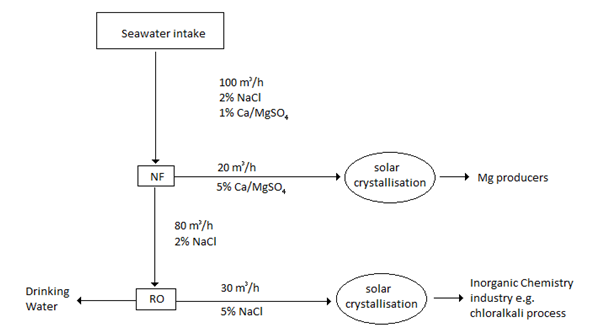It looks like you're using an Ad Blocker.
Please white-list or disable AboveTopSecret.com in your ad-blocking tool.
Thank you.
Some features of ATS will be disabled while you continue to use an ad-blocker.
share:
Abstract
Current risks with our water supply
More from World's Water 1998-1999 biennial report
Other hazards with our irrigation systems
Here are some charts


Links to full articles: www.scielo.br...
www.ncbi.nlm.nih.gov...
What do you guys think?
There is a historical association between wetlands and infectious disease that has led to the modification of wetlands to prevent disease.
At the same time there has been the development of water resources projects that increase the risk of disease. The demand for more water development projects and the increased pressure to make natural wetlands economically beneficial creates the need for an ecological approach to wetland management and health assessment.
The environmental and health interactions are many. There is a need to take into account the landscape, spatial boundaries, and cross-boundary interactions in water development projects as well as alternative methods to provide water for human needs.
The research challenges that need to be addressed are discussed. - ncbi.nlm.nih.gov
Current risks with our water supply
The main parasitic diseases associated with water development projects are schistosomiasis, lymphatic filariasis, onchocerciasis, and malaria. These four diseases have been given priority by the World Bank (Tiffen, 1989) because:
• they can cause death and/or severe disability;
• a large proportion of the population at risk becomes ill;
• the diseases are difficult to control once they become widespread or endemic; and
• ill health lasts a long time.
Other diseases such as Japanese encephalitis are important in more restricted geographical areas.
The increase in artificial wetlands (i.e., water resource development) and the destruction of natural wetlands to decrease disease risk are the major concerns associated with wetlands and disease today.
- scielo.br; World Bank (Tiffen, 1989)
More from World's Water 1998-1999 biennial report
• one-half the world's population lacks basic sanitation services. More than one billion people lack potable drinking water;
• nearly 250 million cases of cholera, dysentery, and other water-related diseases are reported each year;
• water-borne diseases kill between 5-10 million people a year;
• more water for a growing population means greater demand for fresh water for industry, agriculture, and urban areas; and
• more water for human and economic demands means less water available for natural ecosystems, including wetlands and forests. - WCD, 1998); scielo.br
Other hazards with our irrigation systems
• soils present drainage problems, and drainage channels are absent or poorly maintained;
• rice or sugarcane is cultivated;
• reservoirs are built, or pits are left with standing water;
• canals are unlined or have unchecked vegetation growth; and
• there is settlement of new immigrants or resettlement of residents into more compact settlements. People without immunity may come into contact with a new disease, or they may bring a new source of infection with them. New dense resettlements can facilitate disease transmission. - (Tiffen, 1989); scielo.br
Here are some charts


Links to full articles: www.scielo.br...
www.ncbi.nlm.nih.gov...
What do you guys think?
edit on 7-1-2017 by supermilkman because: (no reason given)
edit on 7-1-2017 by supermilkman because: (no reason
given)
Starting a New Thread?...Look Here First
AboveTopSecret.com takes pride in making every post count.
Please do not create minimal posts to start your new thread.
If you feel inclined to make the board aware of news, current events,
or important information from other sites
please post one or two paragraphs,
a link to the entire story,
AND your opinion, twist or take on the news item,
as a means to inspire discussion or collaborative research on your subject.
AboveTopSecret.com takes pride in making every post count.
Please do not create minimal posts to start your new thread.
If you feel inclined to make the board aware of news, current events,
or important information from other sites
please post one or two paragraphs,
a link to the entire story,
AND your opinion, twist or take on the news item,
as a means to inspire discussion or collaborative research on your subject.
edit on Sun Jan 8 2017 by DontTreadOnMe because: (no
reason given)
a reply to: supermilkman
There is an association between jungle and infectious diseases, famine an disease, poverty, war, storms, flooding and infectious disease, too.
Limiting it to 'wetlands', sounds like they want to drain the swamp, kill of the deltas for good, I mean for bad.
There is a historical association between wetlands and infectious disease that has led to the modification of wetlands to prevent disease.
There is an association between jungle and infectious diseases, famine an disease, poverty, war, storms, flooding and infectious disease, too.
Limiting it to 'wetlands', sounds like they want to drain the swamp, kill of the deltas for good, I mean for bad.
a reply to: supermilkman
My favorite thing about your article is where you write
"Here are some charts"
Like they are just filler.
Question, what do you think? What are the arguments for or against this subject?
My favorite thing about your article is where you write
"Here are some charts"
Like they are just filler.
Question, what do you think? What are the arguments for or against this subject?
originally posted by: intrptr
a reply to: supermilkman
There is a historical association between wetlands and infectious disease that has led to the modification of wetlands to prevent disease.
There is an association between jungle and infectious diseases, famine an disease, poverty, war, storms, flooding and infectious disease, too.
Limiting it to 'wetlands', sounds like they want to drain the swamp, kill of the deltas for good, I mean for bad.
Yes, you're right. Basically everything poses a possible threat. The main thing is that our water supply is probably toxic.
In my third industrial revolution thread I have given suggests for
A: replacing chemical water treatment with Electro-deionization and reverse osmosis systems
B: using renewable biofuels that can purify human waste water.
Another issue that I don't know how to solve is our trade, commuting, etc. I guess develop immunities to diseases at this point?
edit on
8-1-2017 by supermilkman because: (no reason given)
originally posted by: TheAlleghenyGentleman
a reply to: supermilkman
My favorite thing about your article is where you write
"Here are some charts"
Like they are just filler.
Question, what do you think? What are the arguments for or against this subject?
I think the tables speak for themself. Once a point has been made there's no reason to keep over-analyzing it.
a reply to: supermilkman
Of course chemically treated water is better than drinking straight from river basins. Also just realized I'm splitting hairs with the algae.
Chemicals used for disinfection
www.lenntech.com...
Environmental groups and concerns over water treatment process
investigations.nbcnews.com...< br />
CDC - Chemicals used for disinfection
www.cdc.gov...
So even though these chemicals are better than the alternative, I think reverse osmosis, Nanofiltration, and EDI would work better.
The algae can be used to purify sewer water then be processed again.
Yes, I'm also aware that toilet-to-tap programs already exist.
Of course chemically treated water is better than drinking straight from river basins. Also just realized I'm splitting hairs with the algae.
Chemicals used for disinfection
www.lenntech.com...
Chemicals that are used are for instance sodium chloride, potassium chloride, citric acid and chlorine dioxide. Chlorine dioxide cleansing serves the removal of organic contaminants on ion exchange resins. - Lenntech
Environmental groups and concerns over water treatment process
investigations.nbcnews.com...< br />
Researchers analyzed results from water quality tests done in 2011 at 201 large municipal water systems that serve more than 100 million people in 43 states. They found trihalomethanes, a byproduct of chlorination, in every system. The EPA calls some members of this class of chemicals “probable human carcinogens” and studies have linked them to bladder cancer, birth defects and miscarriages. However, only one water treatment system exceeded the EPA’s limits for the chemicals, which was set at 80 parts per billion in 1998.
But the report argued that the EPA’s limits are too lax, citing several studies linking even lower levels of the chemicals to health problems. For example, in 2011 a French research team analyzing data from three countries found that men exposed to more than 50 parts per billion of trihalomethanes [try-hal-o-MEH-thanes] had significantly increased cancer risks.
CDC - Chemicals used for disinfection
www.cdc.gov...
Disinfection
After the water has been filtered, a disinfectant (for example, chlorine, chloramine) may be added in order to kill any remaining parasites, bacteria, and viruses, and to protect the water from germs when it is piped to homes and businesses.
So even though these chemicals are better than the alternative, I think reverse osmosis, Nanofiltration, and EDI would work better.
The algae can be used to purify sewer water then be processed again.
Yes, I'm also aware that toilet-to-tap programs already exist.
When the BP oil spill happened there was a news article of this company trying to get a contract to help clean up. Guess it never happened since BP
decided to go the corexit way. I think this companies technology has a lot of potential in helping to treat contaminated water and making it reusable
for future use.
Ecosphere Technology
algae bloom before and after treatmen of ozonix
Ecosphere Technology
Ecosphere Technologies Saves Local Marina From Closing Down; Destroys Toxic Algae Bloom
STUART, FL -- (Marketwired) -- 07/20/16 -- Ecosphere Technologies, Inc. (OTCQB: ESPH), a technology development and intellectual property licensing company, today announced that it completed a one week operation to revitalize a local marina that was virtually shut down due to a toxic cyanobacteria "blue-green algae" bloom the size of a football field with 4" to 12" thick of toxic algae and hundreds of dead fish on the surface. Presenting not only an environmental disaster, but also a health hazard to the local community, Ecosphere deployed its equipment and personnel at its own cost to help save the local business and to demonstrate the effectiveness of its patented, high-volume, chemical-free water treatment technology.
algae bloom before and after treatmen of ozonix
edit on
8-1-2017 by Alchemst7 because: (no reason given)
a reply to: supermilkman
Or maybe instead of replacing chemical water treatment we just add another process of ion exchange and reverse osmosis system towards the end of it?
Nanofiltration would be great for ships and the Navy.
Or maybe instead of replacing chemical water treatment we just add another process of ion exchange and reverse osmosis system towards the end of it?
Nanofiltration would be great for ships and the Navy.
a reply to: supermilkman
Then again the Navy already uses desalinization. A lot of this isn't really a big problem I guess.
Then again the Navy already uses desalinization. A lot of this isn't really a big problem I guess.
a reply to: supermilkman
Here's a cool picture.
Ships are being used as desalination ports.


Here's a cool picture.
Ships are being used as desalination ports.


edit on 8-1-2017 by supermilkman because: (no reason given)
originally posted by: Alchemst7
When the BP oil spill happened there was a news article of this company trying to get a contract to help clean up. Guess it never happened since BP decided to go the corexit way. I think this companies technology has a lot of potential in helping to treat contaminated water and making it reusable for future use.
Ecosphere Technology
Ecosphere Technologies Saves Local Marina From Closing Down; Destroys Toxic Algae Bloom
STUART, FL -- (Marketwired) -- 07/20/16 -- Ecosphere Technologies, Inc. (OTCQB: ESPH), a technology development and intellectual property licensing company, today announced that it completed a one week operation to revitalize a local marina that was virtually shut down due to a toxic cyanobacteria "blue-green algae" bloom the size of a football field with 4" to 12" thick of toxic algae and hundreds of dead fish on the surface. Presenting not only an environmental disaster, but also a health hazard to the local community, Ecosphere deployed its equipment and personnel at its own cost to help save the local business and to demonstrate the effectiveness of its patented, high-volume, chemical-free water treatment technology.
algae bloom before and after treatmen of ozonix
Thanks for the link. It looks like it can purify sludge into pure water.
a reply to: supermilkman
I have a huge interest in water works and will eventually open up my own water store to offer the community the best water available to drink. Ecosphere uses no chemicals but a combination of ozone, hydro and acustic cavitation and
Electrochemical oxidation. This process kills and destroys all bacteria and parasites in the water.
I have a huge interest in water works and will eventually open up my own water store to offer the community the best water available to drink. Ecosphere uses no chemicals but a combination of ozone, hydro and acustic cavitation and
Electrochemical oxidation. This process kills and destroys all bacteria and parasites in the water.
originally posted by: Alchemst7
a reply to: supermilkman
I have a huge interest in water works and will eventually open up my own water store to offer the community the best water available to drink. Ecosphere uses no chemicals but a combination of ozone, hydro and acustic cavitation and
Electrochemical oxidation. This process kills and destroys all bacteria and parasites in the water.
Sounds like a plan. So it's a combination of chemical water treatment and then electro-deionization? Sounds good. I just recommend a reverse osmosis system towards the end of it to create ultra-pure water.
This is unrelated but it shows a typical water treatment process.
edit on 8-1-2017 by supermilkman because: (no reason given)
a reply to: supermilkman
Nice video. My mom retired from the Las Vegas water polution control facility on east side of Vegas. I got to go many times to tour the facility and see how it works.
Nice video. My mom retired from the Las Vegas water polution control facility on east side of Vegas. I got to go many times to tour the facility and see how it works.
Do you know why they speculate that so many are now exhibiting allergies and autoimmune disorders?
It's because so many are obsessed with sterilizing everything. Our immune systems are designed to encounters a certain number of bacteria and viruses in our lifetime and when our immune systems are not challenged, the risk is there for them to start misfiring and attacking us instead because they aren't trained properly.
Now, no one is advocating that we allow serious disease organisms into our water supply, but having your immune system encounter a few bugs here and there is actually good for you. Trust me. I am married to a microbiologist and you pick up a few things.
It's because so many are obsessed with sterilizing everything. Our immune systems are designed to encounters a certain number of bacteria and viruses in our lifetime and when our immune systems are not challenged, the risk is there for them to start misfiring and attacking us instead because they aren't trained properly.
Now, no one is advocating that we allow serious disease organisms into our water supply, but having your immune system encounter a few bugs here and there is actually good for you. Trust me. I am married to a microbiologist and you pick up a few things.
new topics
-
Nearly 70% Of Americans Want Talks To End War In Ukraine
Political Issues: 13 seconds ago -
Late Night with the Devil - a really good unusual modern horror film.
Movies: 1 hours ago -
Cats Used as Live Bait to Train Ferocious Pitbulls in Illegal NYC Dogfighting
Social Issues and Civil Unrest: 3 hours ago -
The Good News According to Jesus - Episode 1
Religion, Faith, And Theology: 5 hours ago -
HORRIBLE !! Russian Soldier Drinking Own Urine To Survive In Battle
World War Three: 7 hours ago -
Bobiverse
Fantasy & Science Fiction: 10 hours ago -
Florida man's trip overseas ends in shock over $143,000 T-Mobile phone bill
Social Issues and Civil Unrest: 10 hours ago
top topics
-
Florida man's trip overseas ends in shock over $143,000 T-Mobile phone bill
Social Issues and Civil Unrest: 10 hours ago, 8 flags -
SETI chief says US has no evidence for alien technology. 'And we never have'
Aliens and UFOs: 14 hours ago, 7 flags -
Cats Used as Live Bait to Train Ferocious Pitbulls in Illegal NYC Dogfighting
Social Issues and Civil Unrest: 3 hours ago, 7 flags -
This is our Story
General Entertainment: 16 hours ago, 4 flags -
Former Labour minister Frank Field dies aged 81
People: 12 hours ago, 4 flags -
Bobiverse
Fantasy & Science Fiction: 10 hours ago, 3 flags -
Late Night with the Devil - a really good unusual modern horror film.
Movies: 1 hours ago, 2 flags -
HORRIBLE !! Russian Soldier Drinking Own Urine To Survive In Battle
World War Three: 7 hours ago, 2 flags -
The Good News According to Jesus - Episode 1
Religion, Faith, And Theology: 5 hours ago, 0 flags -
Nearly 70% Of Americans Want Talks To End War In Ukraine
Political Issues: 13 seconds ago, 0 flags
active topics
-
Cats Used as Live Bait to Train Ferocious Pitbulls in Illegal NYC Dogfighting
Social Issues and Civil Unrest • 9 • : ImagoDei -
Nearly 70% Of Americans Want Talks To End War In Ukraine
Political Issues • 0 • : Consvoli -
British TV Presenter Refuses To Use Guest's Preferred Pronouns
Education and Media • 142 • : Annee -
President BIDEN Vows to Make Americans Pay More Federal Taxes in 2025 - Political Suicide.
2024 Elections • 101 • : ImagoDei -
Late Night with the Devil - a really good unusual modern horror film.
Movies • 3 • : Hecate666 -
HORRIBLE !! Russian Soldier Drinking Own Urine To Survive In Battle
World War Three • 23 • : Disgusted123 -
Hi folks I'm Leon Grad
Introductions • 9 • : leongrad -
The Reality of the Laser
Military Projects • 41 • : 5thHead -
Thousands Of Young Ukrainian Men Trying To Flee The Country To Avoid Conscription And The War
Other Current Events • 136 • : NorthOS -
Florida man's trip overseas ends in shock over $143,000 T-Mobile phone bill
Social Issues and Civil Unrest • 16 • : grey580


